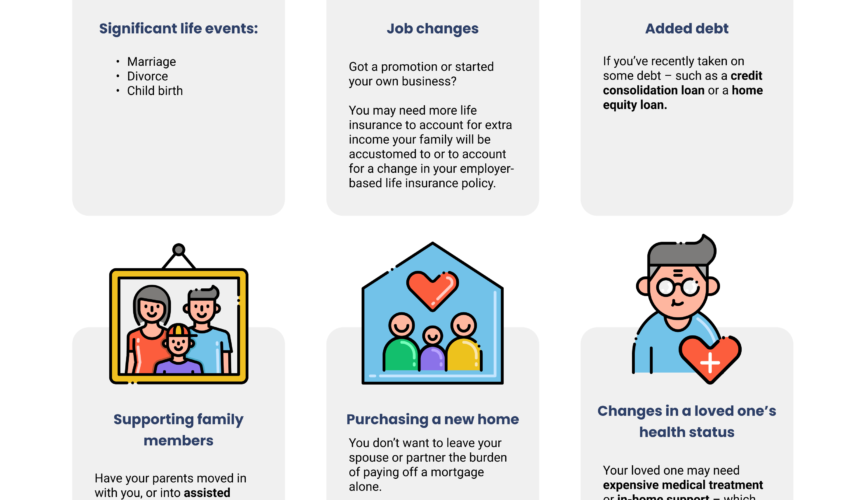Life Insurance Anderson SC is a way to provide money when you die. It can help with funeral expenses, student loans, and mortgage payments.
You can also use it to provide a death benefit for dependants. Many factors determine your life insurance premium. Younger people are typically more affordable, as are nonsmokers and people without complex medical issues.

A term life insurance policy provides a death benefit for a set number of years, such as 10, 20, or 30. It is a good option if you have debts or other financial obligations that will need to be paid off if you die. It is also an excellent choice for people who don’t want to pay the higher premiums of whole-life insurance.
Before purchasing a policy, you should carefully consider what your needs are. If you want to provide a death benefit for your family, you should calculate how much income they would need to cover living expenses and debts after your death. You should also consider other sources of income that your beneficiaries may have access to, such as social security benefits.
You can get a term life policy from a variety of companies. To choose a company, you should look at its reputation for customer satisfaction and claims handling. You can find this information from reputable sources like the Better Business Bureau and the National Association of Insurance Commissioners. It’s also important to consider the company’s financial stability. Check its ratings by A.M. Best, Moody’s, and Standard & Poor’s.
Term life policies are generally the least expensive type of life insurance. They are also the easiest to buy because they don’t require a medical exam. Many term policies have the option to renew on a year-to-year basis, but this can lead to a significant increase in premiums. You should also know that some term policies can convert to whole life insurance without a medical exam.
Whole life insurance is more expensive than term life, but it has some advantages that make it worth the investment. Its consistent death benefits offer a safety net for your loved ones, and its cash value can be used as an asset you can draw on during retirement. It is often a better choice for those who have long-term financial obligations, such as children’s college education or a mortgage. It is also a good choice for people who want to leave behind a legacy, such as funds for their heirs or charitable donations.
Whole life insurance is a form of permanent coverage that typically lasts your entire life. It builds consistent cash value over time and offers a guaranteed death benefit to help your family pay funeral costs, outstanding debts, or other end-of-life expenses. It also provides a tax-favorable return on the premiums you’ve paid, known as accumulated dividends.
You can choose between a traditional whole-life policy and an interest-sensitive whole-life policy, which allocates investment earnings differently to reflect current market conditions. This allows you to take advantage of increases in interest rates while minimizing the impact on your cash value and death benefit.
In addition to providing a death benefit, whole life insurance policies can be used as collateral for bank loans, which helps give you more financial flexibility. You can also access your accumulated cash value through withdrawals or policy loans, generally income tax-free. This flexibility can be a valuable asset for anyone who wants to protect their family’s financial security or create a lasting legacy.
People purchase whole life insurance primarily to provide their families and businesses with a death benefit that will cover any debts and other expenses that may be left behind. It can also help them plan for future needs, such as retirement income, college tuition, or estate planning. In addition, whole life insurance can be used to build wealth and protect an estate from creditors.
Several types of whole life insurance include level premium whole life insurance and indexed universal life. Level premium whole life insurance offers lifetime protection with fixed monthly premiums guaranteed to stay the same for your entire life. You can also choose a limited payment whole-life policy with fixed premium levels for a period.
If you are considering purchasing a whole life insurance policy, it’s important to research and choose a company with a high rating from reliable, independent sources. A good place to start is by asking friends and family for recommendations or contacting a financial professional who specializes in life insurance.
Universal life is a type of permanent life insurance that gives you flexibility with your premium payments and cash savings. This type of life insurance can help you provide a death benefit for your loved ones and grow your investments simultaneously. The death benefits are typically federal income tax-free and can be transferred separately from your estate. Unlike other types of life insurance, you can also adjust the amount of your premiums (within limits).
With a universal life policy, you can choose from several investment options for your cash value account. Depending on your preferences, you can invest in funds that match your risk tolerance or diversify your portfolio by investing in various asset classes. You can also decide to make automatic investments or take an active role in choosing your fund choices.
Three types of universal life policies exist fixed universal life, indexed universal life, and variable universal life. Each has its own set of advantages and disadvantages. A variable universal life policy lets you invest in sub-accounts managed by a professional investment manager. This may be appealing to investors who are more interested in the market and want the potential for higher returns. However, these policies have high fees and are more complex than other life insurance options.
Another drawback of universal life is that it requires careful monitoring. It would help if you kept an eye on the death benefit and the cash value because it’s possible that you could run out of money before your death. The additional policy charges can destroy your cash value until you have none left. If you don’t monitor your policy, it could lapse, meaning no death benefit will be paid to your beneficiaries.
If you’re considering a universal life insurance policy, consult with an independent financial advisor to understand the pros and cons of this type of coverage. They can also order a policy review from a company like Veralytic to compare the quality of a particular policy with others in the industry. This can give you a more objective perspective and help you choose the best product for your needs.
A variable life insurance policy is a permanent life insurance product that provides flexible premiums and the opportunity for higher cash value growth through market investments. It also offers flexibility in choosing investment sub-accounts and a death benefit. However, these policies can be more expensive than other types of permanent coverage, such as whole life insurance. In addition, these policies are often more volatile and can experience negative returns that may affect the cash value and death benefit.
You must undergo a standard life insurance medical exam to qualify for a variable life insurance policy. A licensed healthcare provider administers the exam, typically involving an EKG, blood pressure, and chest X-ray. During this process, the insurance company will review your application details and determine whether you are a good candidate for a policy. During the underwriting process, the insurer will consider your age, health status, lifestyle, and other factors. These factors will determine the amount of coverage you will receive.
Unlike other permanent life insurance products, which offer a guaranteed rate of return, the cash value in a variable life insurance policy is based on the performance of your selected investment options. This can make it difficult to predict the exact amount you will receive at your death, especially if your investment loses value.
The cash value in a variable life insurance policy accumulates on a tax-deferred basis, so you will only be liable for federal income taxes when you withdraw money from the account. You can also borrow against the policy’s cash value, which will result in a taxable event.
Variable life insurance is best suited for consumers with a high level of risk tolerance and a strong understanding of the market. It is unsuitable for individuals who want to avoid market losses that could negatively impact their death benefits or those with a low income, as they are likely to pay high fees and premiums for this type of policy. If you are considering a variable life insurance policy, consult with a fee-only financial adviser to ensure it aligns with your financial goals and risk tolerance.


